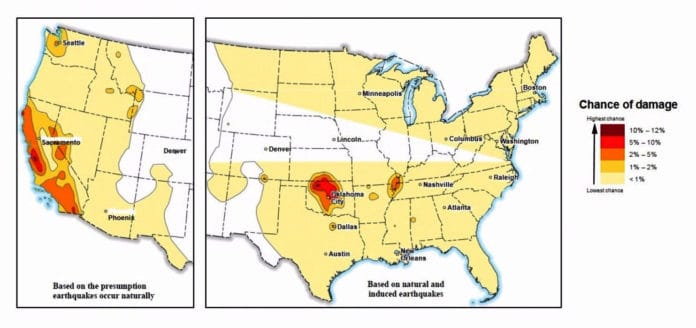Earthquakes are a natural hazard — except when they’re man-made. The oil and gas industry has aggressively adopted the technique known as hydraulic fracturing, or fracking, to shatter subsurface shale rock and liberate the oil and gas lurking there. But the process results in tremendous amounts of chemical-laden wastewater, which the industry disposes of by pumping into deep wells.
And the Earth moves.
On Monday, the U.S. Geological Survey published for the first time an earthquake hazard map covering both natural and “induced” quakes. The map and an accompanying report indicate that parts of the central United States now face a ground-shaking hazard equal to the famously unstable terrain of California.
Some 7 million people live in places vulnerable to these induced tremors, the USGS concluded. The list of places at highest risk of man-made earthquakes includes Oklahoma, Kansas, Texas, Arkansas, Colorado, New Mexico, Ohio and Alabama. There are also states with wastewater-disposal wells but no record of recent natural earthquakes — suggesting that the practice of injecting wastewater deep into the Earth can be done more safely in some places than in others.
It’s not immediately clear whether this new research will change industry practices, or even whether it will surprise anyone in the areas of newly estimated risk. In Oklahoma, for example, the natural rate of earthquakes is only one or two a year, but there have been hundreds since fracking became commonplace in the last decade.
“By including human-induced events, our assessment of earthquake hazards has significantly increased in parts of the U.S.,” Mark Peterson, chief of the USGS National Seismic Hazard Mapping Project, said in a release.
The report, based on recent seismic activity, is just a one-year hazard assessment. In effect, the scientists have said that what has happened in the recent past with induced earthquakes will likely happen in the near future — hardly a radical finding. The goal is to help communicate the risks to the general public. Past USGS hazard maps didn’t include man-made events.
“Having it quantified authoritatively will be helpful in establishing just how much danger there is,” Michael Blanpied, associate coordinator of the USGS Earthquake Hazards Program, told The Washington Post.
With a few exceptions, locations in the nation’s central and eastern regions are not generally thought of as seismically unstable. But, Blanpied said, “Pretty much everywhere has faults. The nation was built over a billion years, and lots and lots of faults are left over from the construction process.”
The fluids injected into the deep wells don’t lubricate the faults so much as put additional pressure on them, driving their walls apart, he noted.
A fault running between Dallas and the adjacent city of Irving caused a magnitude 3.6 earthquake in January 2015. That was attributed to natural causes, though an injection well was only about six miles away, said Heather R. DeShon, a seismologist at Southern Methodist University. But the USGS identifies the huge Dallas metropolitan area as one of the main places vulnerable to a significant earthquake because of human factors.
“The new map serves as a reminder to the local populations living with the recent earthquakes that it is best to be prepared to feel ground shaking,” said DeShon, who was not involved in the new study.






